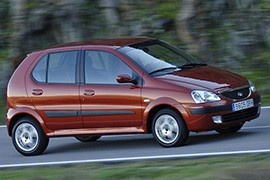
TATA MOTORS Indica
Generations Timeline, Specs and Pictures

Launched initially as a hatchback version for the better known Indica, it was sold mainly in India.
The connection with the Indica name, which is associated mostly with cheap taxi vehicles, was a drawback for some of the customers. Other than that, the three engine choices, from which two were diesel and one was gasoline, offered decent power and fuel consumption for the Indian market.
The base engine was a 1.1-liter gasoline unit with 68 hp and 98 Nm (72.3 lb-ft) of torque. The other two engines were 1.3- and 1.4-liter turbodiesel engines with 88 hp and 70 hp, respectively. No, this is not a mistake. The smaller engine had a higher power output since it was the more updated 1.3-liter Multijet engine from Fiat.
The bodywork was, basically, a shortened Tata Indica, sharing the same platform. The car was 3.8 meters (12.5 ft) long and had a small, 232 liter (8.2 cu-ft) trunk. But it had the minimum requirements for what the Indian car market needed. The only standard features were the power steering and the air-conditioning. The top version was also equipped with dual airbags and seatbelts for all the seats. No ABS was offered for the Indica Vista. Due to the low sales, the Vista was withdrawn from production in December 2015.

Tata Indica was the first car designed with the Indian customer in mind, and Ratan Tata was the driving force behind it.
After eight years since the market liberalization in India, Tata unveiled the Indica at the 1998 New Dehli Auto Expo in Pragati Maidan. The audience was keen to see the new car, which promised to be cheap to buy, cheap to run, and tailored for the Indian market.
Ratan Tata didn’t trust its design department from Telco Industries, who knew how to create trucks and buses. He relied on the Italian I.DE.A design studio, and the result was a modern-looking vehicle that could feel at home either in the suburbs of New Delhi or in any European city. Its rounded shapes and curved headlights followed the new-edge design theme, which was just revealed on some other European cars.
Inside, despite the low-quality materials, the Indica showed a modern look. Its curved dashboard featured an open storage area in front of the driver and a digital clock in the middle, at the base of the windshield. Tata installed the ventilation controls on the upper side and the audio system underneath it on the center stack. The Indica didn’t feature any sound system for the lower trim levels and left that job for their owners. Despite its small size, the car could accommodate up to five occupants inside, but with very limited legroom for the rear-seat occupants.
Under the hood, the Indica was the only direct-injected diesel engine on the Indian market for many years. It was a fuel-efficient vehicle but with inferior performances. The other option was a 1.4-liter gasoline unit. Later on, the Indica received better powerplants and improved interiors and materials.























































